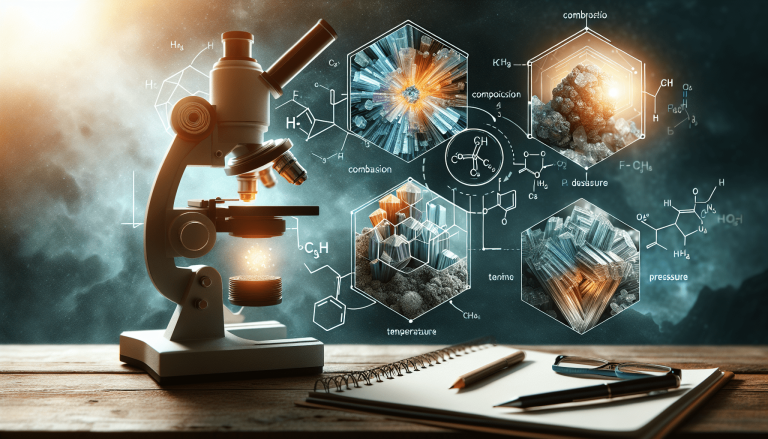Analyzing The Importance Of Mineral Chemical Properties In Gemology
Gemology is a fascinating field that uncovers the secrets behind the captivating world of gemstones. One crucial aspect of this study is understanding the importance of mineral chemical properties. By analyzing these chemical properties, gemologists gain valuable insights into the formation, quality, and value of gemstones. From determining a gem’s durability and color to assessing its authenticity, the mineral chemical properties serve as a treasure trove of information for those passionate about the beauty and allure of precious stones. In this article, we will explore the significance of mineral chemical properties in the realm of gemology and why they are an indispensable tool for gemologists.

Introduction
Gemology is the scientific study of gemstones, including their properties, formation, identification, and value. A crucial aspect of gemology is the understanding and analysis of mineral chemical properties. Mineral chemical properties refer to the chemical composition and characteristics of minerals that make up gemstones. By examining and assessing these properties, gemologists can gain valuable insights into the nature and quality of gemstones.
Physical Properties of Minerals
Color
The color of a gemstone is one of the most visually striking and recognizable physical properties. However, color alone is not enough to accurately identify or evaluate a gemstone. The color of a gemstone is determined by the presence of trace elements or structural impurities that selectively absorb or reflect certain wavelengths of light. For example, the presence of chromium gives a ruby its vibrant red color, while iron impurities create the green hue in emeralds.
Hardness
Hardness is a crucial physical property that measures a gemstone’s resistance to scratching and abrasion. The hardness of a gemstone is determined by its molecular structure and the strength of the chemical bonds holding its atoms together. The Mohs scale is commonly used to classify the hardness of gemstones, with diamonds ranking as the hardest mineral at 10. Understanding the hardness of a gemstone is vital for determining its durability and suitability for various jewelry applications.
Crystal Structure
The crystal structure refers to how the atoms or molecules within a gemstone are arranged in a repeating pattern. Different minerals exhibit unique crystal structures, which contribute to their physical properties. For instance, the crystalline structure of quartz gives it excellent transparency and optical properties, making it a popular gemstone. Examining the crystal structure of a gemstone can aid in its identification and authentication.
Cleavage and Fracture
Cleavage and fracture properties describe how a gemstone breaks when subjected to external forces. Cleavage refers to the tendency of a mineral to split along specific planes of weakness, resulting in smooth and flat surfaces. Fracture, on the other hand, occurs when a gemstone breaks irregularly, producing rough and uneven surfaces. These properties can provide insights into the internal structure and integrity of a gemstone, impacting its durability and value.
Specific Gravity
Specific gravity measures the density of a gemstone relative to the density of water. It is a fundamental physical property that can help in gemstone identification. Each mineral has a unique specific gravity due to variations in their elemental composition. By measuring the specific gravity of a gemstone, gemologists can obtain valuable clues about its identity and differentiate between similar-looking gemstones.
Chemical Composition of Minerals
Elemental Composition
The elemental composition of a gemstone refers to the types and proportions of chemical elements present within the mineral. Gemstones are composed of various elements, including oxygen, carbon, silicon, and various trace elements. The elemental composition directly influences the physical and optical properties of gemstones, such as color, hardness, and refractive index. Analyzing the elemental composition is essential for gemstone identification and determining their suitability for specific applications.
Trace Elements
Trace elements are present in small amounts within gemstones and can have a significant impact on their color and overall appearance. For example, the presence of iron in peridot results in its distinctive yellow-green hue, while the presence of vanadium creates the blue color in sapphires. Trace elements play a crucial role in determining the unique characteristics and value of gemstones, making their identification and analysis essential for gemologists.
Structural Impurities
Structural impurities refer to irregularities or defects in a gemstone’s crystal lattice structure. These impurities can be naturally occurring or introduced during the gemstone’s formation process. Structural impurities can affect a gemstone’s optical properties, such as its transparency or ability to transmit light. Their presence can also impact a gemstone’s durability, as they may create weaknesses or vulnerabilities within the crystal structure.
Isomorphism
Isomorphism is a phenomenon where different elements with similar chemical properties can substitute for one another within a crystal lattice structure. This substitution can occur during the formation of a gemstone, resulting in variations in its chemical composition and physical properties. Isomorphism plays a crucial role in the color variability of gemstones within the same mineral species. For example, the presence of iron or magnesium in garnets can contribute to variations in their color, such as red, green, or yellow.
Gemstone Formation
Factors influencing gemstone formation
Gemstones form through a complex process that involves various geological and environmental factors. The formation of gemstones requires specific conditions of temperature, pressure, and chemical composition within the Earth’s crust. Factors such as the presence of specific minerals, geological activity, and the availability of water or other solvents can influence the formation of gemstones. Understanding these factors is crucial for locating and identifying gemstone deposits.
The role of mineral chemical properties in the formation process
Mineral chemical properties play a significant role in the formation of gemstones. The elemental composition, presence of trace elements, and structural impurities within minerals determine their suitability for gemstone formation. For example, the presence of chromium within certain minerals is a critical factor in the formation of rubies and emeralds. By studying the chemical properties of minerals, gemologists can gain insights into the geological processes that lead to gemstone formation.

Identification and Classification of Gemstones
Gemstone identification techniques
Identification of gemstones involves a combination of visual inspection, physical testing, and advanced laboratory techniques. Gemologists use tools such as loupes, refractometers, polariscopes, and spectrometers to examine and analyze gemstones. Visual characteristics, such as color, transparency, and luster, are often the first indicators used in the identification process. Sophisticated techniques like spectroscopy and X-ray diffraction are employed to determine the precise chemical composition and crystal structure of gemstones.
Use of mineral chemical properties in gemstone identification
Mineral chemical properties are foundational to gemstone identification. By analyzing the chemical composition and trace elements present in a gemstone, gemologists can narrow down the possibilities and determine its mineral species. Chemical tests, such as acid tests or thermal conductivity measurements, can help confirm the identity of a gemstone. The use of mineral chemical properties provides a scientific and objective basis for gemstone identification, reducing the risk of misidentification or fraud.
Classification of gemstones based on chemical properties
Gemstones can be classified into different groups based on their chemical properties. For example, the beryl mineral species includes gemstones such as emeralds, aquamarines, and morganites, all of which have a similar chemical composition (beryllium aluminum silicate). Chemical properties can also be used to distinguish between natural and synthetic gemstones. Analyzing the chemical properties allows gemologists to categorize gemstones accurately, aiding in their understanding and evaluation.
Gemstone Treatments and Enhancements
Common treatments and enhancements in the gem trade
Gemstone treatments and enhancements are widely practiced in the gemstone industry to improve their appearance or marketability. Common treatments include heat treatment, irradiation, and diffusion to enhance color or clarity. Other techniques, such as filling fractures or applying coatings, can improve a gemstone’s visual appeal. These treatments and enhancements may alter the chemical properties of gemstones, affecting their overall quality and value.
Detection and evaluation of treatments
Gemologists employ various methods to detect and evaluate gemstone treatments and enhancements. Advanced spectroscopic techniques, such as Raman spectroscopy and infrared spectroscopy, can identify specific changes in a gemstone’s chemical composition. Microscopic examination and careful observation can reveal signs of treatment, such as filled fractures or color zoning. Detecting and evaluating treatments is essential for determining the true nature and value of gemstones.
Impact of chemical properties on treatments and enhancements
The chemical properties of gemstones influence the effectiveness and outcomes of various treatments and enhancements. Different gemstones have different chemical compositions, which can react differently to specific treatments. For example, heat treatment can intensify the color of certain gemstones by rearranging their atomic structure or altering the oxidation state of trace elements. Understanding the chemical properties of gemstones is crucial for determining the suitability and potential impact of specific treatments.
Gemstone Durability and Stability
Factors affecting gemstone durability
Durability is a crucial consideration when evaluating gemstones for jewelry use. Various factors can affect the durability of a gemstone, such as its hardness, cleavage, and resistance to environmental factors like heat, light, and chemicals. Gaining an understanding of a gemstone’s physical and chemical properties is vital for assessing its durability and ensuring its long-term stability and wearability.
Chemical stability of gemstones
Chemical stability refers to a gemstone’s resistance to chemical reactions or changes when exposed to different environments or substances. Some gemstones are more chemically stable than others, meaning they can withstand exposure to acids, moisture, or temperature variations without significant damage. The chemical composition and crystal structure of a gemstone greatly impact its chemical stability. Assessing the chemical stability of gemstones is crucial for determining their suitability for different settings or environments.
Relation between chemical properties and durability
The chemical properties of gemstones play a significant role in determining their durability. Gemstones with strong chemical bonds and resistance to chemical reactions, such as diamonds, are highly durable and suitable for everyday wear. On the other hand, gemstones with weaker chemical bonds or greater susceptibility to chemical reactions may require special care and limited exposure to certain substances. Understanding the relationship between chemical properties and durability is essential for proper gemstone selection and maintenance.
Gemstone Value
Influence of chemical properties on gemstone value
Chemical properties significantly influence the value of gemstones. Rarity and desirability often result from specific chemical compositions or combinations of trace elements. For example, the scarcity of red diamonds can be attributed to the presence of nitrogen impurities. Likewise, the presence of chromium in emeralds contributes to their unique green color and higher value. The chemical properties of gemstones directly impact their market demand and perceived worth.
Rarity and desirability of certain chemical compositions
Gemstones with unique or rare chemical compositions are highly sought after in the market. Natural phenomena, such as the presence of certain trace elements or impurities, can create vivid colors or optical effects that increase the desirability and value of gemstones. For instance, the presence of copper impurities results in the vibrant blue color of turquoise, making it highly prized. The rarity and desirability of gemstones are often determined by their distinctive chemical properties.
Examples of valuable gemstone chemical properties
Several gemstones derive value from their specific chemical properties. Rubies, for instance, owe their value to the presence of chromium, which imparts their vibrant red color. Sapphires come in various colors like blue, yellow, or pink due to trace elements like iron and titanium. The presence of manganese contributes to the vivid green color of tsavorite garnets. These examples highlight how particular chemical properties add value and desirability to gemstones.
Emerging Trends in Gemology
Advances in spectroscopy and chemical analysis techniques
The field of gemology is constantly evolving, and technological advancements have had a significant impact on analyzing mineral chemical properties. Spectroscopic techniques, such as Raman spectroscopy and laser-induced breakdown spectroscopy (LIBS), allow for more accurate identification and chemical analysis of gemstones. These techniques provide detailed information about a gemstone’s elemental composition, trace elements, and crystal structure, aiding gemologists in their research and understanding.
Impact of technology on understanding mineral chemical properties
Technology has been instrumental in deepening our understanding of mineral chemical properties. Sophisticated instruments, such as electron microscopes and X-ray diffractometers, allow for precise analysis of a gemstone’s crystal structure and composition. Imaging techniques, such as electron backscatter diffraction (EBSD), provide detailed information about crystal defects and impurities. The use of technology complements traditional gemological methods and enhances our understanding of mineral chemical properties.
Future prospects and developments in gemology
The future of gemology holds promising developments in understanding mineral chemical properties. Researchers are constantly exploring new techniques and technologies to improve gemstone analysis and identification. Nanotechnology, for example, shows potential in creating gemstone replicas or enhancing the performance of treated gemstones. Additionally, advancements in artificial intelligence and machine learning can aid in automating gemstone identification and analysis processes. These future prospects hold exciting possibilities for the field of gemology.
Conclusion
Mineral chemical properties play a vital role in gemology, enabling gemologists to understand, identify, and appreciate gemstones. From the physical properties of color and hardness to the chemical composition, trace elements, and crystal structure, analyzing these properties provides valuable insights into the nature, formation, value, and durability of gemstones. Understanding mineral chemical properties enhances gemologists’ ability to accurately identify gemstones, assess their quality, and determine their market value. By appreciating the role of chemical properties, we gain a deeper understanding and appreciation of the intricate world of gemstones and their significance in jewelry and trade.







